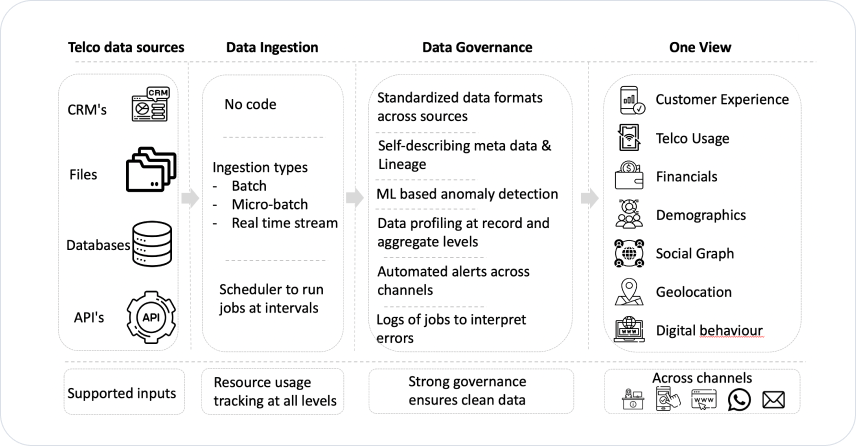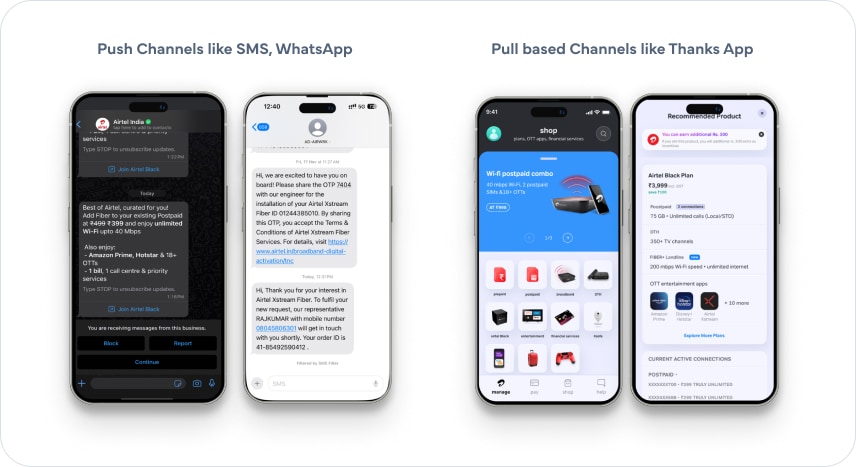Xtelify’s Data Engine ramps up convergence play for Airtel. Increases adoption of fixed mobile convergence by 2x.
-
January 6, 2025
5 min read
Overview
India boasts of the world’s second-largest telecommunications market by the number of subscribers (both fixed and mobile), exceeding 1.19 billion as of December 2023. The overall tele-density (phone subscriptions per 100 people) stands at around 85.76%, with significant growth potential in rural areas (currently at 59.44%). The disruptive strategies of the market led by a highly competitive landscape forces a lot of innovation driven by digitization to stay on top.
To stay ahead in today’s competitive telecom landscape, maximizing customer lifetime value and driving growth have become paramount. However, fragmented data silos often hinder operators from gaining a holistic understanding of their customers, making it difficult to deliver personalized experiences and targeted offerings. Xtelify partnered with Airtel, one of India’s leading telecom providers, to address this challenge.
The Challenge
- Cut-throat competition in the Indian telecom market pushed Airtel to unify and expand their offerings to drive ARPU. The goal was simple:
- Driving stickiness: Adding flexi bundles & plans with discount: Airtel sought to increase customer adoption of Fixed Mobile Convergence plans, combining postpaid and fixed-line services for greater value for customers with unmatched offers – to grow ARPU
- Seamless targeting to cross-sell on existing customer base: Airtel wanted to deliver a consistent and personalized experience across all touchpoints, whether online, in-store, or through call centers – to facilitate cross-sell and increase plan adoption
But this was easier said than done. Airtel faced numerous roadblocks to bring this vision to life. Doing so traditionally wasn’t feasible – ultimately hindering marketing and sales teams alike. To effectively ramp up convergence play and increase ARPU, Airtel had to effectively cross the below hurdles in a limited period of time.
- Airtel lacked a single view of the customer as data existed in fragments in siloed systems no way to link with various other data pools from network, CRMs etc.
- Lost opportunities for sales as no real-time and relevant customer information available Customer received promotional messages when the network was poor or he had filed complaints
- Lack of a true omni channel capabilities as no synergy between internal systems led to poor visibility of the customer buying journey Customer had to share their details multiple times which led to poor customer experience
The Xtelify Solution – Data Engine:
Xtelify implemented its Data Engine (DE) to address Airtel’s challenges. DE is a TM Forum-compliant data model built on deep telco industry expertise. It offered several key features that were crucial for Airtel:
- Unified Customer Profile: DE ingests data from multiple sources in batch mode as well as real time streams to create a single view of each customer, encompassing demographics, purchase history, service usage, and interactions across channels etc. Strong governance ensured high quality data which is eventually used for business intelligence.
- Intelligent Insights to cross-sell on existing customer base: Through AI and machine learning, DE analyzes customer data to identify preferences, predict churn risk, and recommend personalized plans and offers.
- Omni channel targeting: DE empowered Airtel to provide a true omni channel experience to the customer where relevant information was present across Thanks App, Web App etc. This led to higher conversions in scenarios where the customer dropped off at any step in an acquisition journey
Airtel leveraged the above features and created a unique offering called Airtel Black where a customer could club multiple offerings basis their requirements, had the capability to get a single bill for products consumed and could manage and view all live subscriptions from the same window. From the customer front end, it meant a unified, one view for all engagements and ultimately a superior experience. From Airtel’s end, they had one view of the customer across different parameters, unlocked targeted recommendations and promotions to the right customer and increased revenue.
How did Xtelify implement these features in the Airtel ecosystem?

Recommendations for driving convergence were shown across channels resulting into higher conversions

Digital tools for frontline teams
| Before Xtelify Card | After Xtelify Card | |
| Increased adoption of fixed mobile convergence by 125% Card | Airtel’s adoption of Fixed Mobile offerings hovered at only 20% due to lack of data. | Adoption of fixed mobile plans surged from 20% to 45%, demonstrating the effectiveness of data-driven convergence strategies |
| Industry beating ARPU Card | Due to lack of single view of customer, Airtel was unable to drive personalized campaigns for customers which hindered cross-sell capabilities and ultimately ARPU | DE allowed Airtel to drive higher fixed mobile convergence adoption and executed targeted marketing campaigns directly resulting in increased revenue generation and higher ARPU. |
These results translate to tangible business benefits for Airtel:
- Enhanced Customer Satisfaction: Personalized recommendations and unified customer experience across touchpoints led to higher customer satisfaction.
- Improved Operational Efficiency: DE’s automation and streamlined data management reduced operational costs and freed up resources for other initiatives.
Conclusion
Airtel’s success story showcases the power of Xtelify’s Data Engine in unlocking customer data’s potential for telecom operators. By creating a single customer view, generating intelligent insights, and facilitating personalized offerings, DE empowered Airtel to achieve significant business growth through data-driven convergence and customer-centric marketing. This case study demonstrates how Xtelify’s innovative solutions can help telco companies transform their customer experience and achieve sustainable growth.